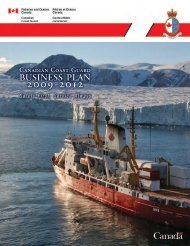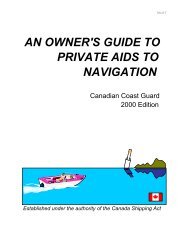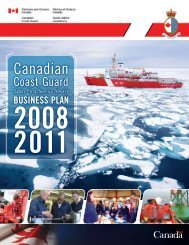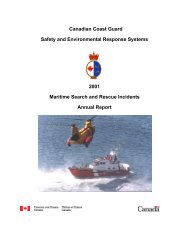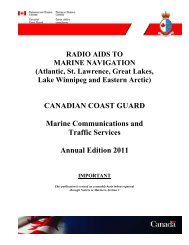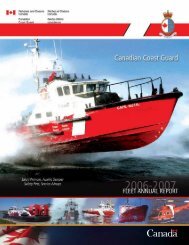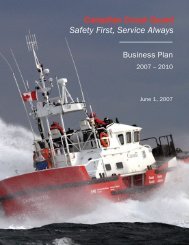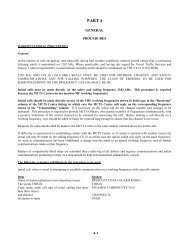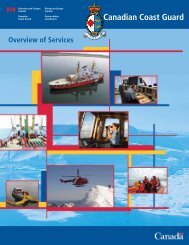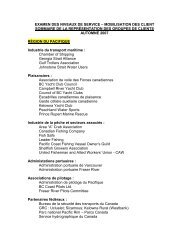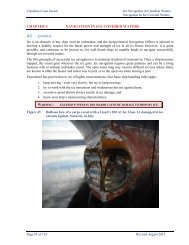RADIO AIDS TO MARINE NAVIGATION - Canadian Coast Guard
RADIO AIDS TO MARINE NAVIGATION - Canadian Coast Guard
RADIO AIDS TO MARINE NAVIGATION - Canadian Coast Guard
You also want an ePaper? Increase the reach of your titles
YUMPU automatically turns print PDFs into web optimized ePapers that Google loves.
ii)<br />
has absolute priority over all other transmissions and all coast radio stations and ships that hear this call must cease<br />
any transmissions that will interfere with it and must listen on the frequency used for this call.<br />
The Distress Message consists of:<br />
i) the word “MAYDAY”;<br />
ii) the name of the ship in distress;<br />
iii) the position of the ship in distress;<br />
iv) the nature of the distress;<br />
v) the kind of assistance needed;<br />
vi) any other useful information which might assist the rescue;<br />
vii) the word “Over” which is an invitation to acknowledge and reply.<br />
Distress Traffic consists of all messages about the immediate assistance required by the ship in distress. Prior to the<br />
transmission of any Distress Traffic, the Distress Signal “MAYDAY” must be sent once before the call. The control of<br />
Distress Traffic is the responsibility of the ship in distress or of the ship or coast radio station sending a Distress Message.<br />
A mobile station that learns that another mobile station is in distress may transmit the distress message if:<br />
i) the station in distress cannot transmit it;<br />
ii) the master or person responsible for the craft carrying the station which intervenes believes that further help is<br />
necessary;<br />
iii) although not in a position to render assistance, it has heard a distress message which has not been acknowledged.<br />
In the above situation the distress message takes the following form:<br />
i) the radiotelephone Alarm Signal if possible;<br />
ii) the words “MAYDAY RELAY” (spoken three times);<br />
iii) the words “This is”;<br />
iv) the identification of the mobile station repeating the message (spoken three times).<br />
When Distress Traffic has ceased or when silence is no longer necessary the station that has controlled the Distress Traffic<br />
must transmit a message on the distress frequency advising that the distress traffic has ceased:<br />
i) the word “MAYDAY”;<br />
ii) the words “All Stations” (spoken three times);<br />
iii) the words “This is”;<br />
iv) the name of the station which has controlled the distress traffic;<br />
v) MMSI number (if applicable);<br />
vi) the current Coordinated Universal Time (UTC);<br />
vii) the name of the ship that was in distress and a brief description of the resolution of the distress;<br />
viii) the words “SEELONCE FEENEE”;<br />
ix) the word “Out”.<br />
Distress Procedure Example<br />
Transmission of the Alarm Signal for between 30 seconds and one minute, if possible, then the following spoken slowly<br />
and distinctly:<br />
Distress Signal<br />
“MAYDAY” (three times)<br />
the words<br />
“This is”<br />
name of ship<br />
“Nonsuch” (three times)<br />
MMSI number “316010115”<br />
Distress Signal<br />
“MAYDAY”<br />
name of ship<br />
“Nonsuch”<br />
position<br />
“Off Iles-St-Marie”<br />
nature of distress<br />
“Struck rock and taking on water”<br />
assistance needed<br />
“Require help to abandon ship”<br />
other useful information<br />
“5 persons on board”<br />
invitation to acknowledge and reply “Over”<br />
4-6



